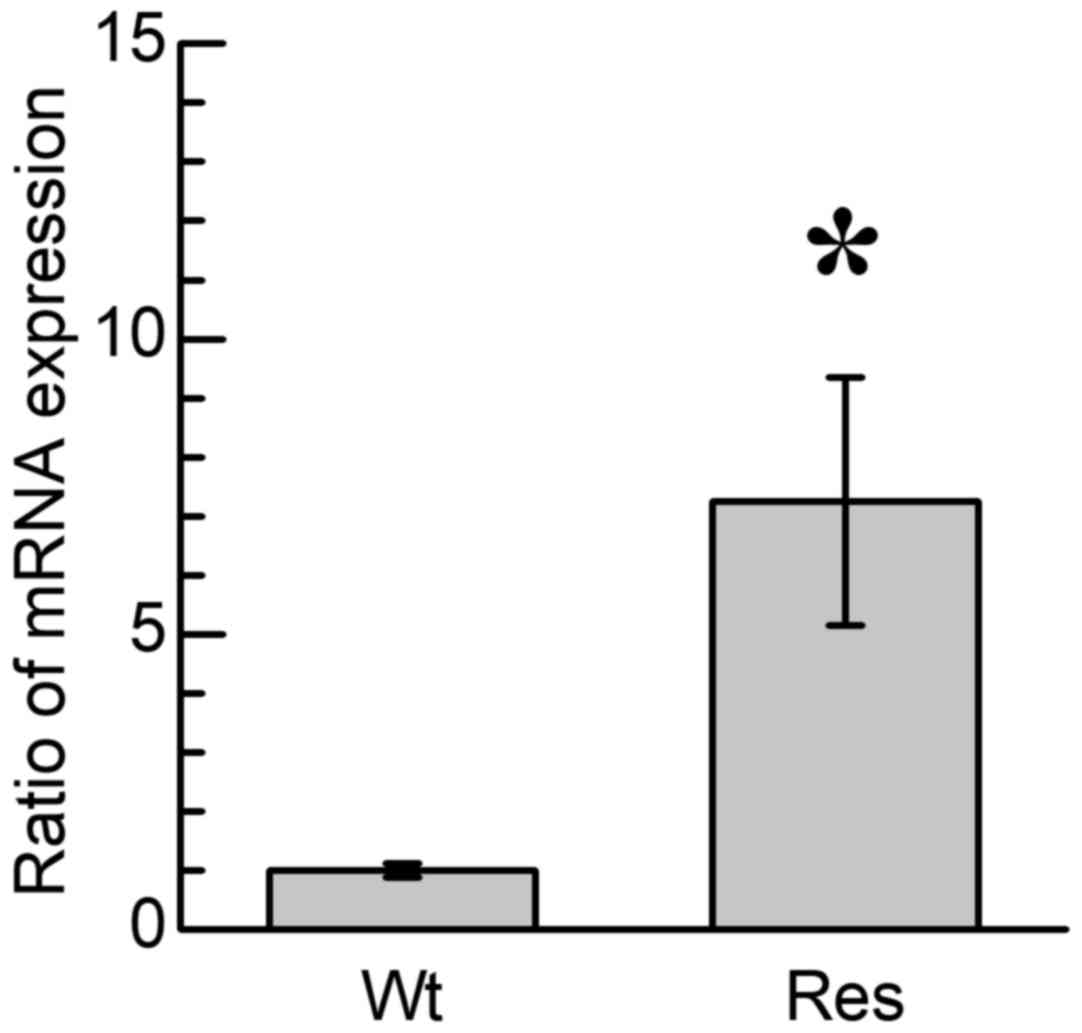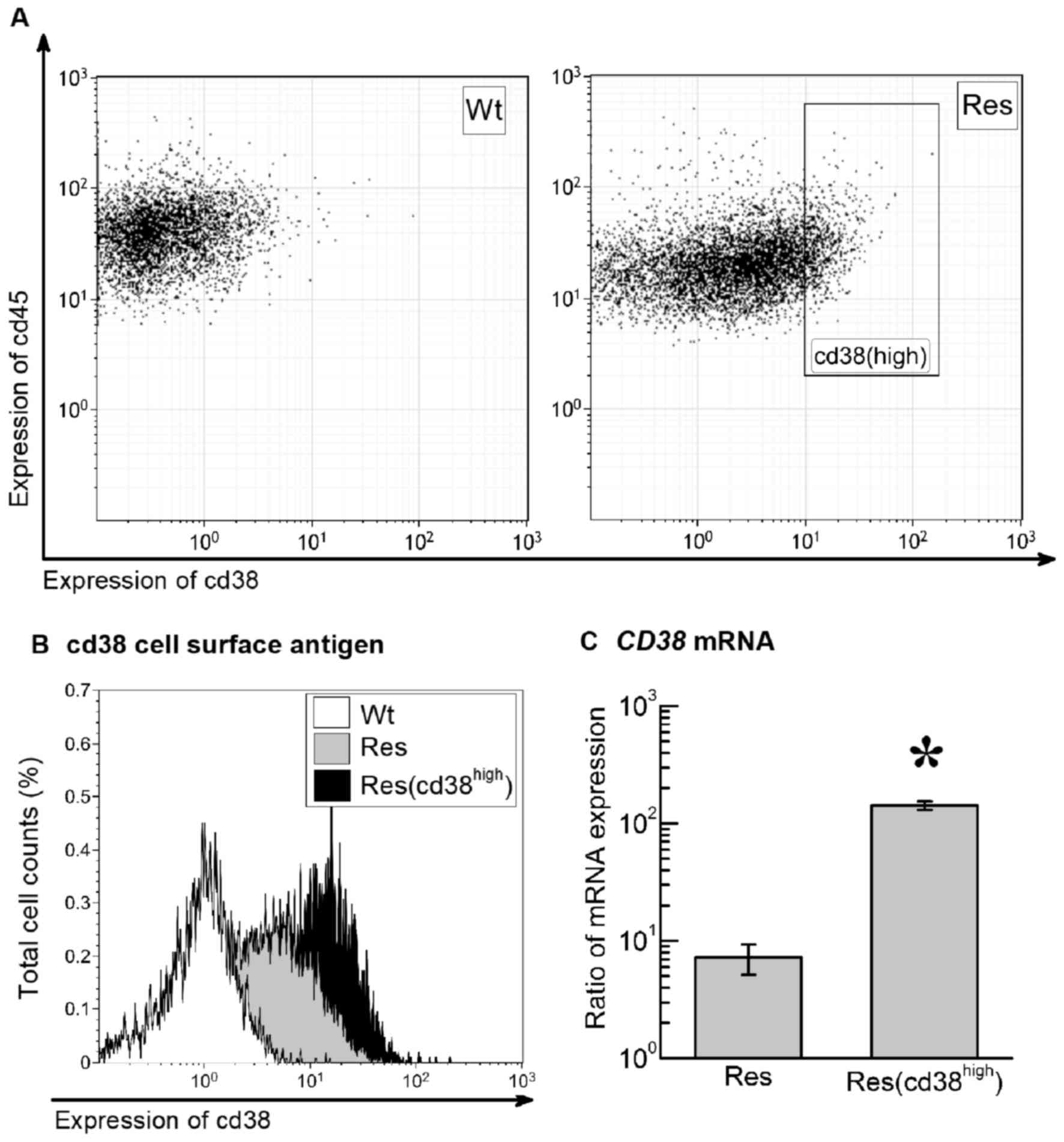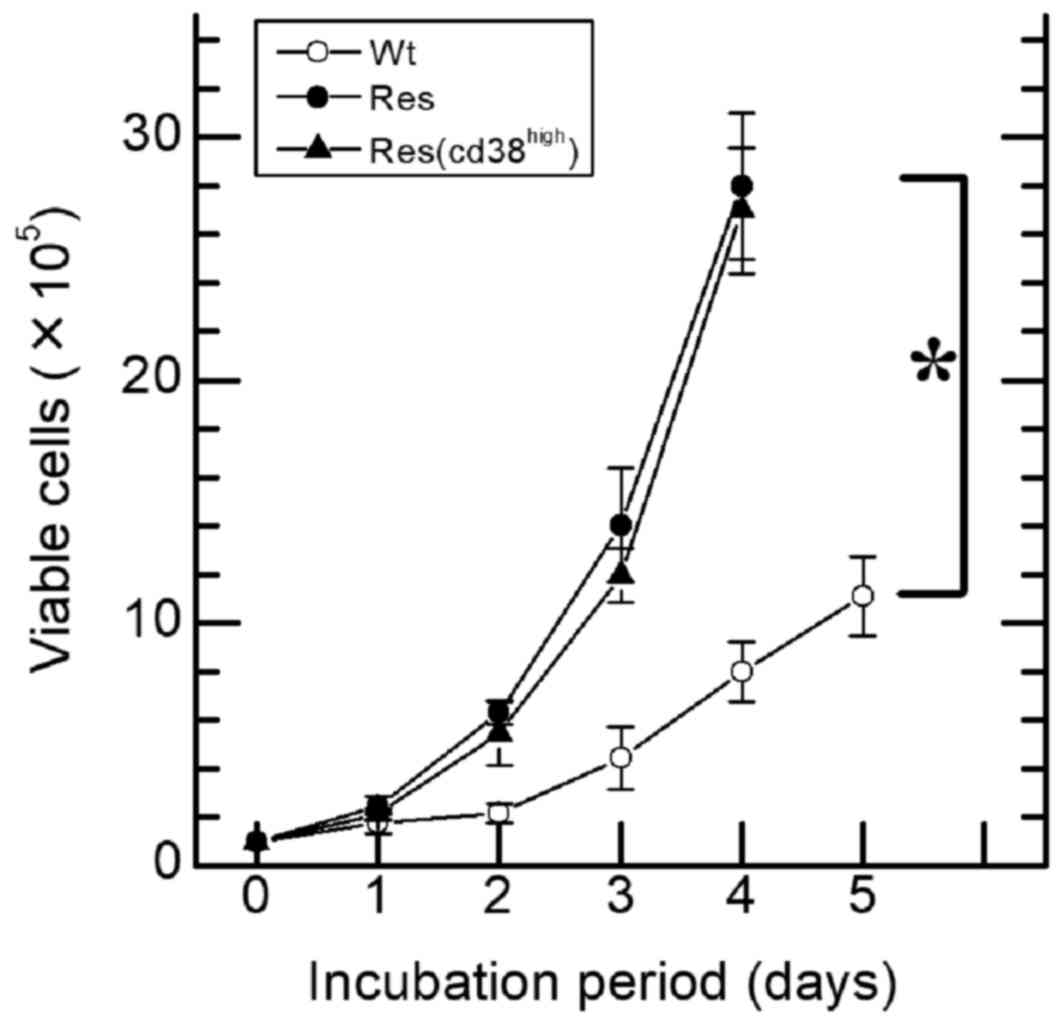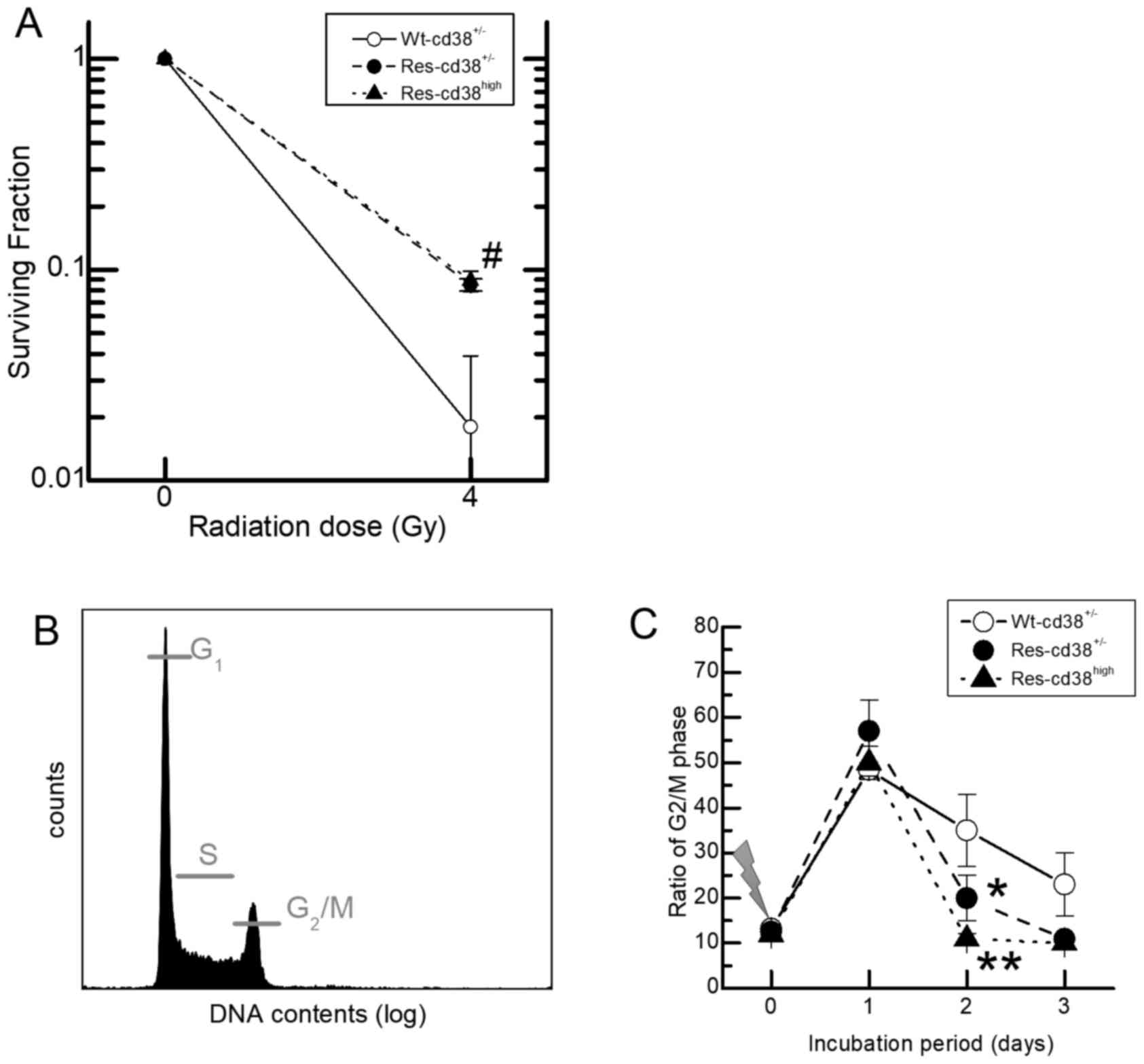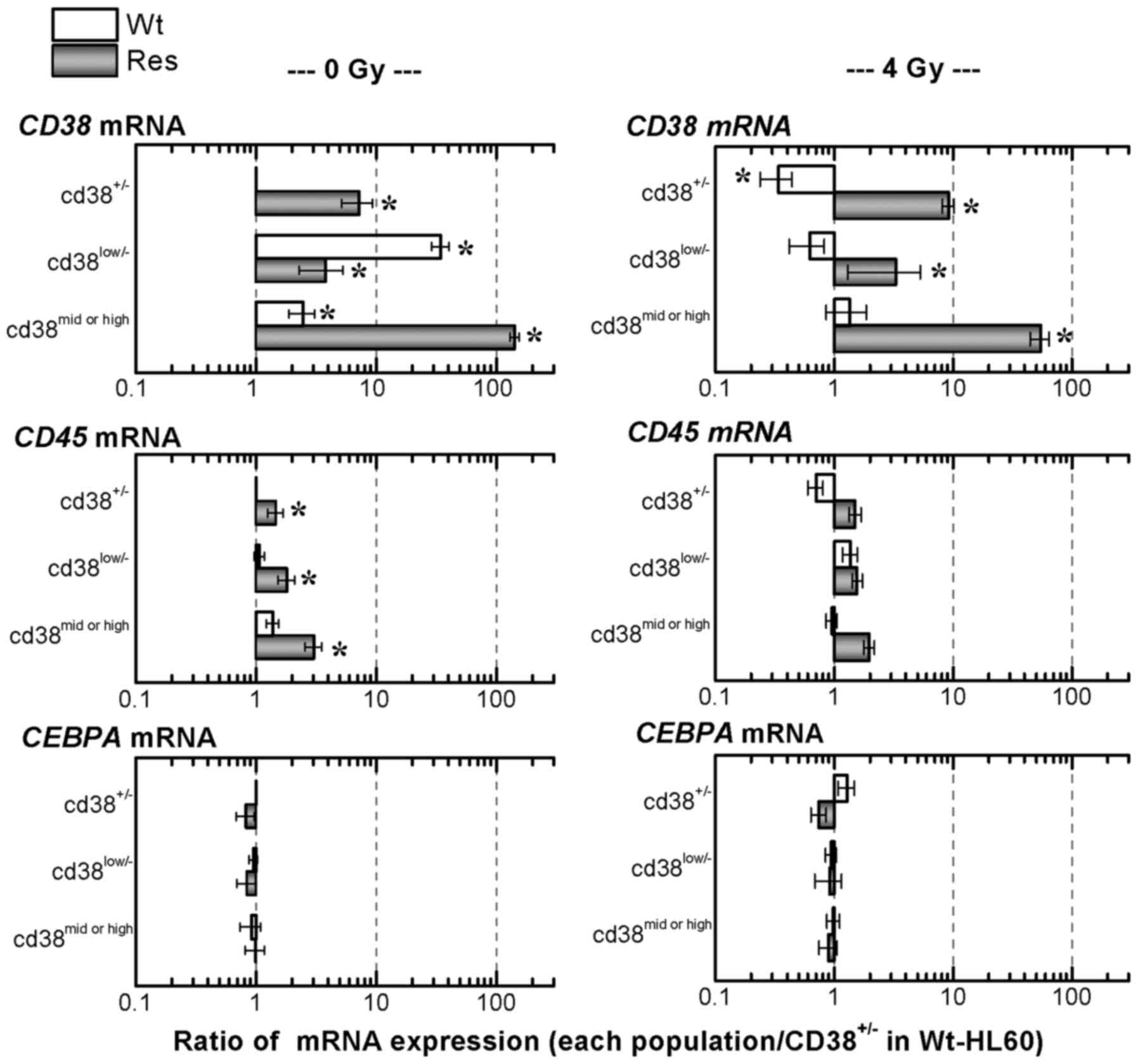A radioresistant fraction of acute promyelocytic leukemia cells exhibit CD38 cell-surface antigen and mRNA expression
- Authors:
- Published online on: February 21, 2018 https://doi.org/10.3892/ol.2018.8099
- Pages: 6709-6714
Abstract
Introduction
Leukemic cells and normal hematopoietic tissues are generally more radiosensitive compared with other tissue types (1–3). One method of leukemia treatment, the depletion of leukemia cells by ionizing radiation (IR), exploits this characteristic to restore a normal hematopoietic system (4,5). However, IR may induce the production of radioresistant cells, as radiation induces genetic mutation. The presence of radioresistant cells may result in a poor prognosis for radiation therapy (6). The properties of radioresistant human HL60 acute promyelocytic leukemia (APL) (Res-HL60) cells, a cell line established as an APL model, have been previously reported (6,7). It was observed that high-cluster of differentiation (CD)38-expressing cells were present among the Res-HL60 cells. However, to the best of our knowledge, the properties of the cell population exhibiting high CD38 expression have never been investigated. If the association between CD38 expression and radioresistance can be determined, key factors and countermeasures against the production of radioresistant cells in radiation therapy may be identified.
In the present study, the cell viability and the expression of CD38 mRNA were evaluated in Res-HL60 APL cells.
Materials and methods
Reagents
Cell culture medium (RPMI-1640) and penicillin/streptomycin were purchased from Thermo Fisher Scientific, Inc. (Waltham, MA, USA). Fetal bovine serum (FBS) was purchased from Japan BioSerum Co., Ltd. (Hiroshima, Japan). Phycoerythrin (PE)-conjugated antihuman CD38 (cat. no. IM1832U) monoclonal antibodies (mAbs) and PE-cyanin-5-forochrome tandem (PC5)-conjugated antihuman CD45 (cat. no. IM2653) mAbs were purchased from Beckman Coulter, Inc. (Brea, CA, USA). The quantification of viable cells was performed using 0.5% trypan blue liquid solution (Nacalai Tesque, Inc., Kyoto, Japan). In order to analyze gene expression, the Qiagen RNeasy mini kit (Qiagen, Inc., Valencia, CA, USA), the iScript cDNA synthesis kit (Bio-Rad Laboratories, Inc., Hercules, CA, USA) and the iQ SYBR Green Supermix (Bio-Rad Laboratories Inc.) were used.
Irradiation
X-ray irradiation (150 kVp, 20 mA, with 0.5 mm aluminum and 0.3 mm copper filters) was performed using an X-ray generator (MBR-1520R-3; Hitachi, Ltd., Tokyo, Japan) with a distance of 45 cm between the focus and the target. The dose was monitored using a thimble ionization chamber placed next to the sample during the irradiation. The dose rate was ~1 Gy/min, for a total dose of 4 Gy.
Cell preparation and cell culture
Human APL wild-type (Wt) HL60 cells was purchased from RIKEN BioResource Center (Tsukuba, Japan). The Res-HL60 cell line was previously established by subjecting Wt-HL60 cells to 4 Gy X-irradiation/week for 4 weeks (6,7). Wt-HL60 and Res-HL60 cells were maintained in RPMI-1640 medium supplemented with 10% heat-inactivated FBS and 1% penicillin/streptomycin in a humidified atmosphere at 37°C under 5% CO2.
Flow cytometry
Isolations of CD38+CD45+ cells and CD38−CD45+ cells and morphological analysis were performed using fluorescence-activated cell sorting (FACS) with the Aria SORP (BD Biosciences, Franklin Lakes, NJ, USA). The analysis software was used BD FACSDiva v.8.0.1 (BD Biosciences). Samples containing 2×105 cells were incubated under saturated concentrations (500 ng/ml) of the relevant mAbs for 30 min at 4°C, followed by washing and flow cytometric analysis. Isotype-matched mAbs of anti-CD38 (PE-conjugated anti-mouse IgG1 mAb; cat. no. A07796; 500 ng/ml; Beckman Coulter, Inc.) and anti-CD45 (PC5-conjugated anti-mouse IgG1 mAb; cat. no. A07798; 200 ng/ml; Beckman Coulter, Inc.) were used as negative controls. The threshold values of mean fluorescence intensity for negative-, low-, medium- and high-expression groups for CD38 antigen were defined as <0.7, 0.7–2, 2–10 and >10, respectively.
Clonogenic surviving fraction
X-irradiated Wt-HL60 and Res-HL60 cells were cultured using the plasma clot technique, as previously described (8), at 37°C in a humidified atmosphere containing 5% CO2. On the seventh day from the start of irradiation, colonies consisting of >50 cells were counted under an inverted optical microscope.
Total RNA extraction and reverse transcription-quantitative polymerase chain reaction (RT-qPCR)
The cells were harvested after 2 days, and total RNA was extracted using the RNeasy kit and quantified using a NanoDrop system (Thermo Fisher Scientific, Inc., Wilmington, DE, USA). The total RNA quality was confirmed using a 2100 Bioanalyzer (Agilent Technologies Inc., Santa Clara, CA, USA), and first-strand cDNA were synthesized using the iScript cDNA Synthesis kit according to the manufacturer's protocol. The expression of mRNA was then evaluated using qPCR with the iQ SYBR Green Supermix (Bio-Rad Laboratories, Inc.) and a SmartCycler® II (Takara Bio Inc., Otsu, Japan) with the following thermocycler conditions: 95°C for 170 sec, followed by 40 cycles of 95°C for 10 sec, 65°C for 20 sec and 72°C for 30 sec. Relative levels of CD38, CD45 and CCAAT/enhancer-binding protein α (CEBPA) was determined using the 2−ΔΔCq method (9) in cells subjected to 4 Gy X-irradiation after 24 h of no irradiation, subsequent to normalization with the housekeeping gene GAPDH. The oligonucleotide primer sets used for RT-qPCR were purchased from Hokkaido System Science Co., Ltd. (Sapporo, Japan; Table I).
Table I.National Center for Biotechnology Information gene accession numbers and sequences of synthetic human oligonucleotide polymerase chain reaction primers. |
Statistical analysis
Statistical analysis was performed using OriginLab® Pro Version 9.0 for Windows (OriginLab, Northampton, MA, USA). Two-way factorial analysis of variance followed by Tukey's range post-hoc test was used to assess the statistical significance of differences between the control and experimental groups. Data from two groups were analyzed using an unpaired Student's t-test. Data are presented as the mean ± standard error of the mean. A total of 4 individual experiments were performed. P<0.05 was considered to indicate a statistically significant difference.
Results
Analysis of cell viability in CD38+ cells
To clarify the morphological character of Res-HL60 cells, Res-HL60 cells were analyzed using FACS in a previous study; smaller cells with lower granularity were observed in Res-HL60 cells in comparison with Wt-HL60 cells (6). In addition, a significantly higher expression of CD38 protein on the surface of Res-HL60 cells compared with Wt-HL60 cells was observed (6), which concurs with the results of the present study, in which CD38 mRNA expression was significantly increased in the Res-HL60 cells compared with the Wt-HL60 cells (P<0.05; Fig. 1). In previous studies a higher rate of cell proliferation was also observed (6,7).
The CD45 leukocyte-specific antigen was expressed in all Wt-HL60 and Res-HL60 cells. The CD38+ cell proportion of Wt-HL60 and Res-HL60 cells was 35.2 and 67.9% respectively (Fig. 2A and B). On the basis of these data, to confirm whether radiosensitivity is associated with CD38 expression level, the fraction with the highest 15% expression of the CD38 antigen in Res-HL60 cells (CD38high) were isolated using FACS (Fig. 2B). RT-qPCR was used to confirm the high CD38 expression; the CD38 mRNA expression in the Res-HL60-CD38high cells was ~37-fold higher than the non-isolated Res-HL60 cells, representing a significant difference (P<0.05; Fig. 2C). A 4.4±1.3-fold increase in the number of viable Wt-HL60 cells was observed on day 3 in comparison with day 0 (Fig. 3), whereas the number of viable Res-HL60 cells underwent a ~14.0-fold increase by day 3. There was a significant increase in the number of viable cells between Wt and either Res or Res-CD38high cells (P<0.01; Fig. 3). However, viability and morphology (data not shown) did not differ between CD38+/− and CD38high in the Res-HL60 cells.
Cellular response to exposure to 4 Gy X-irradiation
The survival rates of Res-HL60 cells exposed to 4 Gy X-irradiation were estimated for the CD38-expressing fraction with a clonogenic survival assay, with the aim of determining the association between the expression of the CD38 antigen and the survival rate following radiation exposure. The survival rate for Wt-HL60 cells exposed to 4 Gy X-irradiation was ~2%, which was significantly lower than the surviving fraction of Res-HL60 cells, ~10% (P<0.05; Fig. 4A). However, the Res-CD38high cells exhibited a similar sensitivity to Res-CD38low/− cells. In order to investigate the association between the survival rate and the cell cycle distribution, the DNA content of each cell type was analyzed using flow cytometry following the exposure to 4 Gy X-irradiation, to determine the relative fraction of the cell population in G2/M phase (Fig. 4B). A higher ratio of cells arrested at G2/M phase on day 1 in each cell type was observed compared with day 0, which was relatively decreased on days 2 and 3 (Fig. 4C). The proportion of cells in G2/M phase on day 2 was reduced in Res-HL60-CD38high cells in comparison with Wt-HL60-CD38+/−cells (P<0.01) and Res-HL60-CD38low/− cells (P<0.05).
The expression levels of mRNAs associated with cell-surface antigens were evaluated using RT-qPCR (Fig. 5). The expression of the CD38 mRNA in CD38low/− and CD38mid/high Wt-HL60 cells underwent 34.6- and 2.5-fold increases, respectively, in comparison with unexposed Wt-HL60 cells. In CD38+/−, CD38low/− and CD38mid/high Res-HL60 cells, 7.2-fold, 3.8-fold and 142.7-fold increases of CD38 mRNA expression, respectively, were observed compared with unexposed Wt-HL60 cells; the difference in the CD38 mRNA expression in Res-HL60-CD38high cells was particularly remarkable. Additionally, a higher CD45 mRNA expression level in CD38+/−, CD38low/− and CD38mid/high Res-HL60 cells was observed. Significant differences in the CEBPA mRNA expression, a specific marker of mature white blood cells, were not observed in CD38+/−, CD38low/− and CD38mid/high Res-HL60 cells compared with Wt-HL60 cells.
Following the exposure of 4 Gy X-irradiation, the expression of CD38 mRNA in Res-HL60 cells was significantly increased in comparison with unexposed Wt-HL60 cells, and the CD38 mRNA expression in Res-CD38mid/high cells was ~50-fold upregulated (Fig. 5). In contrast, CD45 and CEBPA mRNA expression were similarly expressed in each cell type.
Discussion
The present study focused on the behavior of Res-HL60 APL cells expressing the CD38 cell-surface antigen. Res-HL60 cells expressing high levels of the CD38 antigen were identified and quantified. Consistent with a previous report (7), viability of Res-HL60 cells was higher compared with Wt-HL60 cells, independent of the expression of the CD38 antigen (Fig. 3). At the gene expression level, a higher expression of CD38 mRNA in Res-HL60 cells was observed, particularly in CD38high cells (Fig. 4). However, no significant increase or suppression of CEBPA mRNA was observed. These results reveal that the human radioresistant APL cell line previously established by repeated exposure to IR continued to express the CD38 cell-surface antigen and its mRNA; however, this expression was not associated with the capability for cell viability between subpopulations of radioresistant cells.
CD38 is a novel multifunctional ectoenzyme that is widely expressed in cells and tissues, most notably in leukocytes. The synthesis and hydrolysis of cyclic ADP ribose (cADPR) by CD38 is a marker of human leukocyte differentiation (10), and in the context of hematopoietic progenitors, CD34+CD38− cells are more basal than CD34+CD38+ cells (11). CD45 is a major high-molecular-mass leukocyte cell-surface molecule (12). CEBPA is essential for normal granulopoiesis, and the dominant-negative mutations of the CEBPA gene have been identified in a large proportion of the malignant cells from patients with myeloblastic subtypes of acute myeloid leukemia (13). The results of the present study suggest that the Res-HL60 cells that express the CD38 antigen are at a similar differentiation stage to CD38− cells, given that the expression of CD45 and CEBPA did not significantly differ between them.
The expression of the CD38 antigen in Res-HL60 cells did not affect the cell viability (Fig. 3) or clonogenic survival (Fig. 4A). However, the CD38high cells were less likely to arrest in G2/M phase on day 2 after IR exposure (Fig. 4C). The accumulation of cells in G2/M phase is associated with the repair of cellular damage or the induction of apoptosis (14). It was previously reported that the phosphorylation of H2A histone family, member X (H2AX), Checkpoint kinase 1/2 and DNA-dependent protein kinase, catalytic subunit was suppressed in Res-HL60 cells in comparison with Wt-HL60 cells (7). Fernandez-Capetillo et al (15) reported that G2 checkpoint activation was induced by H2AX and tumor suppressor p53-binding protein 1 phosphorylation, markers of DNA damage. In the present study, Res-HL60 cells expressing higher levels of the CD38 antigen exposed to X-irradiation accumulated in G2/M phase on day 2–3 at a lesser rate to other cell groups, suggesting that CD38 expression in Res-HL60 cells influences the G2/M checkpoint of the cell cycle directly or indirectly.
CD38/cADPR signaling is an important metabolic pathway for insulin secretion following glucose stimulation to intracellular ATP, and activates a range of cell behaviors (16,17). Thus, we hypothesize that the radiosensitivity in HL60 cells with a higher expression of CD38 is associated with the intracellular energy metabolism, including that of glucose-ATP, and does not induce differentiation. The exposure of Res-HL60 cells to 4 Gy X-irradiation induced a higher expression of CD38 mRNA compared with non-exposed cells, with notably higher expression in the CD38high cell fraction (Fig. 5). The constant expression of CD38 in Res-HL60 cells may be the result of a mutation inducing CD38 mRNA expression following repeated exposure to ionizing radiation. X-irradiation, which is low-energy transfer radiation, produces reactive oxygen species (ROS), which cause DNA damage (18). Tessitore et al (19) reported that the microRNA associated with DNA repair are necessary for cancer maintenance. Thus, transcription factors directly and/or indirectly regulating the promoter region for CD38 should be identified (20). In a hematological malignancy model, Yalçintepe et al (21) reported that CD38 participates in the mechanism of drug resistance to chemotherapy. There is a possibility that CD38/cADPR signaling protects from various extracellular stresses to promote radioresistance or anti-cancer drug resistance in leukemia. We hypothesize that CD38 mRNA expression protects the cell from DNA-damaging ROS, as are induced by X-irradiation. However, the present study had limitations, including that the interaction between CD38/cADPR signaling, the CD38 gene network and cell damage by ROS was not evaluated.
Given that the X-irradiation exposure of CD38high Res-HL60 cells did not influence their differentiation level, the suppression of the monocyte lineage induction by Res-HL60 cells, may not directly involve CD45 and CEBPA mRNA (6). There is little information about radioresistant leukemia in clinical literature. The results of the present study may suggest countermeasures against radioresistant leukemia.
In conclusion, the accumulation of the CD38 protein in radioresistant APL, induced by the constant expression of CD38 mRNA following X-irradiation, is a characteristic response of the radioresistant-surviving fraction; however, the accumulated volume of CD38 protein was not observed to influence the extent of radioresistant behavior.
Acknowledgements
The present study was supported by KAKENHI, Grant-in-Aid for Scientific Research (C; General; grant no., 16K10339 SM) and the Grant for Hirosaki University Young Institutional Research (2013–2014).
References
|
Ariyoshi K, Takabatake T, Shinagawa M, Kadono K, Daino K, Imaoka T, Kakinuma S, Nishimura M and Shimada Y: Age dependence of hematopoietic progenitor survival and chemokine family gene induction after gamma irradiation in bone marrow tissue in C3H/He mice. Radiat Res. 181:302–13. 2014. View Article : Google Scholar : PubMed/NCBI | |
|
Monzen S, Yoshino H, Kasai-Eguchi K and Kashiwakura I: Characteristics of myeloid differentiation and maturation pathway derived from human hematopoietic stem cells exposed to different linear energy transfer radiation types. PLoS One. 8:e593852013. View Article : Google Scholar : PubMed/NCBI | |
|
Haro KJ, Scott AC and Scheinberg DA: Mechanisms of resistance to high and low linear energy transfer radiation in myeloid leukemia cells. Blood. 120:2087–2097. 2012. View Article : Google Scholar : PubMed/NCBI | |
|
de Berranger E, Cousien A, Petit A, Peffault de Latour R, Galambrun C, Bertrand Y, Salmon A, Rialland F, Rohrlich PS, Vannier JP, et al: Impact on long-term OS of conditioning regimen in allogeneic BMT for children with AML in first CR: TBI+CY versus BU+CY: A report from the Société Française de Greffe de Moelle et de Thérapie Cellulaire. Bone Marrow Transplant. 49:382–388. 2014. View Article : Google Scholar : PubMed/NCBI | |
|
Willemze AJ, Geskus RB, Noordijk EM, Kal HB, Egeler RM and Vossen JM: HLA-identical haematopoietic stem cell transplantation for acute leukemia in children: less relapse with higher biologically effective dose of TBI. Bone Marrow Transplant. 40:319–327. 2007. View Article : Google Scholar : PubMed/NCBI | |
|
Monzen S, Takimura K, Kashiwakura I and Hosokawa Y: Acute promyelocytic leukemia mutated to radioresistance suppressed monocyte lineage differentiation by phorbol 12-myristate 13-acetate. Leuk Res. 37:1162–1169. 2013. View Article : Google Scholar : PubMed/NCBI | |
|
Hazawa M, Hosokawa Y, Monzen S, Yoshino H and Kashiwakura I: Regulation of DNA damage response and cell cycle in radiation-resistant HL60 myeloid leukemia cells. Oncol Rep. 28:55–61. 2012.PubMed/NCBI | |
|
Kashiwakura I, Kuwabara M, Inanami O, Murakami M, Hayase Y, Takahashi TA and Takagi Y: Radiation sensitivity of megakaryocyte colony-forming cells in human placental and umbilical cord blood. Radiat Res. 153:144–152. 2000. View Article : Google Scholar : PubMed/NCBI | |
|
Yuan JS, Wang D and Stewart CN Jr: Statistical methods for efficiency adjusted real-time PCR quantification. Biotechnol J. 3:112–123. 2008. View Article : Google Scholar : PubMed/NCBI | |
|
Takasawa S, Tohgo A, Noguchi N, Koguma T, Nata K, Sugimoto T, Yonekura H and Okamoto H: Synthesis and hydrolysis of cyclic ADP-ribose by human leukocyte antigen CD38 and inhibition of the hydrolysis by ATP. J Biol Chem. 268:26052–26054. 1993.PubMed/NCBI | |
|
Petzer AL, Hogge DE, Landsdorp PM, Reid DS and Eaves CJ: Self-renewal of primitive human hematopoietic cells (long-term-culture-initiating cells) in vitro and their expansion in defined medium. Proc Natl Acad Sci USA. 93:pp. 1470–1474. 1996; View Article : Google Scholar : PubMed/NCBI | |
|
Charbonneau H, Tonks NK, Walsh KA and Fischer EH: The leukocyte common antigen (CD45): A putative receptor-linked protein tyrosine phosphatase. Proc Natl Acad Sci USA. 85:pp. 7182–7186. 1988; View Article : Google Scholar : PubMed/NCBI | |
|
Pabst T, Mueller BU, Harakawa N, Schoch C, Haferlach T, Behre G, Hiddemann W, Zhang DE and Tenen DG: AML1-ETO downregulates the granulocytic differentiation factor C/EBPalpha in t(8;21) myeloid leukemia. Nat Med. 7:444–451. 2001. View Article : Google Scholar : PubMed/NCBI | |
|
Yamamori T, Yasui H, Yamazumi M, Wada Y, Nakamura Y, Nakamura H and Inanami O: Ionizing radiation induces mitochondrial reactive oxygen species production accompanied by upregulation of mitochondrial electron transport chain function and mitochondrial content under control of the cell cycle checkpoint. Free Radic Biol Med. 53:260–270. 2012. View Article : Google Scholar : PubMed/NCBI | |
|
Fernandez-Capetillo O, Chen HT, Celeste A, Ward I, Romanienko PJ, Morales JC, Naka K, Xia Z, Camerini-Otero RD, Motoyama N, et al: DNA damage-induced G2-M checkpoint activation by histone H2AX and 53BP1. Nat Cell Biol. 4:993–997. 2002. View Article : Google Scholar : PubMed/NCBI | |
|
Takasawa S, Nata K, Yonekura H and Okamoto H: Cyclic ADP-ribose in insulin secretion from pancreatic beta cells. Science. 259:370–373. 1993. View Article : Google Scholar : PubMed/NCBI | |
|
Guedes AG, Rude EP and Kannan MS: Potential role of the CD38/cADPR signaling pathway as an underlying mechanism of the effects of medetomidine on insulin and glucose homeostasis. Vet Anaesth Analg. 40:512–516. 2013. View Article : Google Scholar : PubMed/NCBI | |
|
Yamaguchi M and Kashiwakura I: Role of reactive oxygen species in the radiation response of human hematopoietic stem/progenitor cells. PLoS One. 8:e705032013. View Article : Google Scholar : PubMed/NCBI | |
|
Tessitore A, Cicciarelli G, Del Vecchio F, Gaggiano A, Verzella D, Fischietti M, Vecchiotti D, Capece D, Zazzeroni F and Alesse E: MicroRNAs in the DNA damage/repair network and cancer. Int J Genomics. 2014:8202482014. View Article : Google Scholar : PubMed/NCBI | |
|
Sun L, Iqbal J, Zaidi S, Zhu LL, Zhang X, Peng Y, Moonga BS and Zaidi M: Structure and functional regulation of the CD38 promoter. Biochem Biophys Res Commun. 341:804–809. 2006. View Article : Google Scholar : PubMed/NCBI | |
|
Yalçintepe L, Halis E and Ulku S: Effect of CD38 on the multidrug resistance of human chronic myelogenous leukemia K562 cells to doxorubicin. Oncol Lett. 11:2290–2296. 2016. View Article : Google Scholar : PubMed/NCBI |



